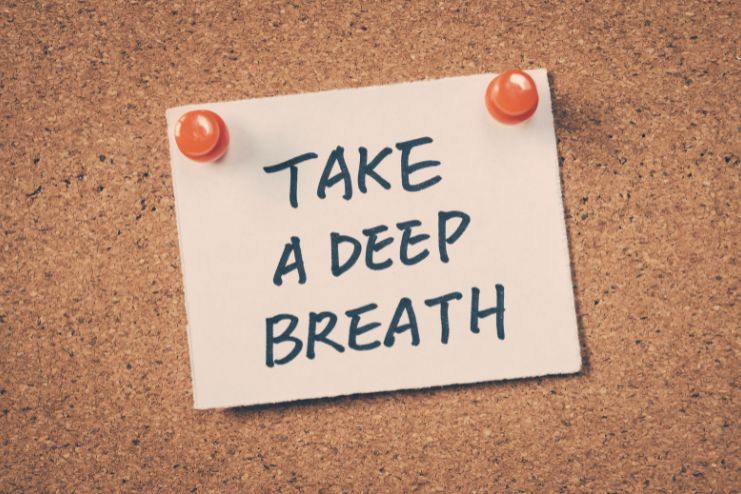AI Contribution
At HealthSpectra, we may use AI to refine grammar and structure, but every piece is shaped, checked, and approved by real people, our expert writers and editors, to ensure clarity, credibility, and care. Learn more..Affiliate Disclaimer
Some links in this article are affiliate links. We may earn a small commission if you make a purchase through these links, at no extra cost to you. We only recommend products we find useful to our readersManaging your weight is not difficult if you make the right choices, including diet and breathing exercises. You can control weight by simple breathing techniques. All you need to do is perform them correctly.
Research and ancient practices show that certain breathing techniques can activate your relaxation response, improve oxygen flow, and help balance hunger hormones. All these factors impact metabolism and support weight loss.
It may surprise you, but stress is a key reason behind stubborn belly fat. High cortisol levels cause your body to store more fat, especially around your stomach. Breathing techniques that burn fat are a natural way to reduce cortisol and promote mindful eating.
Let’s explore how breathwork supports weight loss—and learn four powerful techniques you can start using today.
Read More: 7 Breathing Exercises To Fight Asthma- A Natural Relief and Normal Breath
How Breathwork Supports Fat Loss and Appetite Control

Breathing isn’t just necessary for life, it also helps to regulate the nervous system and metabolic pathways involved in fat loss. Here’s how:
Reduces Cortisol and Emotional Eating: Conscious breathing techniques can play a key role in reducing cortisol levels, calming the nervous system, and countering the effects of stress on fat storage and appetite. Chronic stress increases cortisol, which promotes fat storage around the abdomen and boosts appetite, especially for sugar and high-fat foods.
Slow, conscious breathing encourages the parasympathetic nervous system—the body’s built-in “rest and digest” mode. This helps reduce cortisol production and supports a healthier response to stress, appetite, and fat metabolism.
Regulates Appetite Hormones: Slow, deliberate breathing can also regulate appetite-stimulating hormones such as ghrelin and leptin, making it simpler to distinguish between real hunger and emotional cravings. Ghrelin promotes appetite, and leptin indicates fullness. An imbalance in these hormones often leads to overeating.
While studies continue, new research indicates that mindful breathing can promote hormonal balance and help you identify hunger cues.
Boosts Oxygen Flow and Metabolism: Pairing light exercise with breathwork can substantially increase energy and aid in fat metabolism by enhancing the flow of oxygen in the body. Oxygen plays a key role in fat metabolism—during aerobic respiration, it helps convert stored fat into usable energy (ATP).
By practising diaphragmatic and alternate nostril breathing, you can take deeper breaths, improve lung capacity, and boost oxygen flow. This increases energy during movement and supports better fat-burning while you exercise.
Curbs Cravings Through Parasympathetic Activation: Stimulating the parasympathetic nervous system puts your body into “rest and digest” mode. It not only helps control emotional cravings but also improves digestion and nutrient absorption. This creates a more efficient environment for burning fat.
Read More: 12 Breathing Techniques For Sleep To Drive Insomnia Away
Try these 4 Breathing Techniques
Here are four breathwork practices backed by modern science and ancient traditions to help with appetite suppression and fat burning:
1. Diaphragmatic (Belly) Breathing

Diaphragmatic breathing is also referred to as abdominal or deep breathing. In this technique, the diaphragm is fully engaged with each breath.
Benefits: Belly breathing reduces cortisol, improves digestion, and increases the feeling of fullness and relaxation.
How to do it:
- Sit or recline comfortably with one hand on your stomach.
- Breathe slowly through your nose for 4 seconds, while raising your belly.
- Exhale slowly out of your mouth for 6 seconds, while you feel the belly contract.
- Repeat for 5–10 minutes.
- This exercise can be practiced before dinner or at bedtime to aid in digestion and hormone regulation.
2. Box Breathing (Square Breathing)

Box breathing is a controlled breathing exercise performed by Navy SEALs and athletes to develop concentration and reduce stress.
Benefits: Facilitates control over stress-triggered cravings by regulating cortisol levels and improving self-regulation.
How to do it:
- Breathe in through your nose for 4 counts.
- Hold your breath for 4 counts.
- Slowly breathe out through your mouth for 4 counts.
- Hold your breath once more for 4 counts.
- Repeat the process for 4–8 minutes.
3. Alternate Nostril Breathing (Nadi Shodhana)

Alternate nostril breathing is an ancient yogic breathing technique that harmonizes energy pathways and the nervous system.
Benefits: Encourages relaxation, suppresses cravings, stimulates digestion, and engages the parasympathetic response.
How to do it:
- Sit comfortably and use your thumb to close your right nostril’s opening.
- Inhale deeply from the left nostril.
- Close the left nostril with your ring finger and open the right nostril.
- Exhale slowly via the right nostril.
- Breathe in via the right, close it, and exhale via the left.
- Repeat for 3–5 minutes.
4. Kapalabhati (Skull-Shining Breath)

Kapalabhati is a dynamic breathing technique with brief, forceful exhalations and passive inhalations.
Benefits: Activates the core, increases metabolism, and aids detoxification. It’s invigorating and encourages abdominal fat-burning.
How to do it:
- Sit with your back straight.
- Gently inhale through your nose.
- Forcefully exhale by tightening your abdominal muscles, expelling air.
- Inhale in a relaxed manner.
- Do 30 exhalations in each round; rest and repeat for 2–3 rounds.
Note: Don’t practice Kapalabhati if pregnant, menstruating, or having high blood pressure or respiratory conditions.
Read More: Breathing Exercises for Relaxation
When to Use These Breathing Techniques

The timing of your breathwork practice can significantly affect your metabolism, hunger, and stress management. Using the right technique at the right time can help you suppress food cravings and promote satiety.
Here’s how to get the most out of each technique during your day:
Kapalabhati (Morning): This invigorating method is perfect in the morning to awaken the core, stimulate the nervous system, and kickstart your metabolism. Doing it on an empty stomach prevents mental fog and makes you ready for the day.
Diaphragmatic Breathing (Morning or Night): Diaphragmatic breathing in the morning relaxes the nervous system and stabilizes hunger hormones. When practiced at night, it reduces cortisol and aids in proper sleep. You can also practice it before meals to promote satiety and better digestion.
Box Breathing (Before Meals or When Stressed): Utilize the box breathing technique before eating to reduce stress-related cravings and enhance concentration. It’s also an excellent lunchtime reset option, which helps avoid emotional eating or over-eating during stressful moments.
Alternate Nostril Breathing (Pre-Food or Before Bed): Nadi Shodhana technique before meals helps relax your mind and suppresses unnecessary hunger signals. At night, it soothes the body and enhances the quality of sleep, all of which aid in hormone regulation and fat loss.
Practicing these breathing techniques at the right time daily can boost metabolism, reduce emotional eating, and support steady and healthy weight loss.
Bonus Tips to Maximize Results

- Pair breathwork with gentle exercise such as yoga or walking for an added metabolic boost.
- Practice these breathing exercises before encountering emotional eating cues, such as boredom or stress.
- Combine breathwork with a nutritious diet, as it serves as an excellent supplement but not a substitute for healthy eating.
- Stay consistent with it. Just 5–10 minutes of breathwork daily can shift your nervous system and support your goals.
Conclusion

Breathwork isn’t just a relaxation technique—it’s a practical, science-backed tool for fat loss and appetite control. By tapping into your breath, you can reduce cortisol levels, support your metabolism, and regulate hunger hormones. The best part? You do not need extreme diets or complicated routines to benefit from this.
People have long trusted the power of breath to build resilience, sharpen focus, and promote a more balanced approach to weight management. You don’t require special equipment or an ideal setup. Just a few minutes, a quiet place, and a little consistency.
Your breath is always with you—natural, free, and immensely powerful. Use it to support your body, soothe your cravings, and take charge from the inside out.
References
- https://www.pharmacyscijournal.com/articles/apps-aid1050.php
- https://yogainternational.com/article/view/learn-kapalabhati-skull-shining-breath
- https://www.banyanbotanicals.com/pages/ayurvedic-nadi-shodhana-pranayama
- https://www.banyanbotanicals.com/pages/ayurvedic-nadi-shodhana-pranayama
- https://www.webmd.com/balance/what-is-box-breathing
- https://pmc.ncbi.nlm.nih.gov/articles/PMC10132211/
In this Article

















